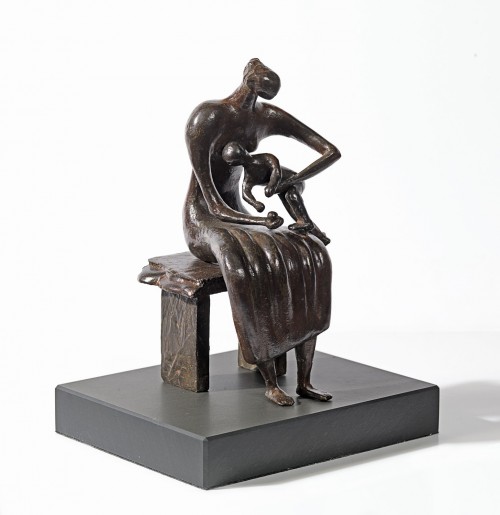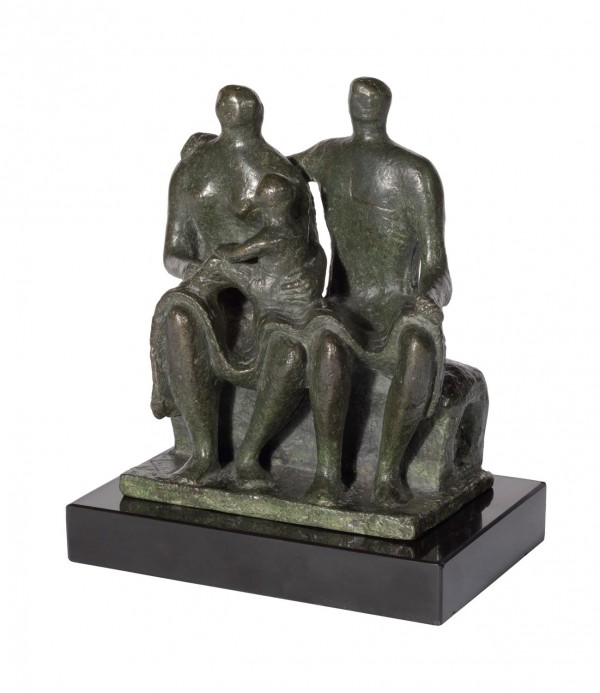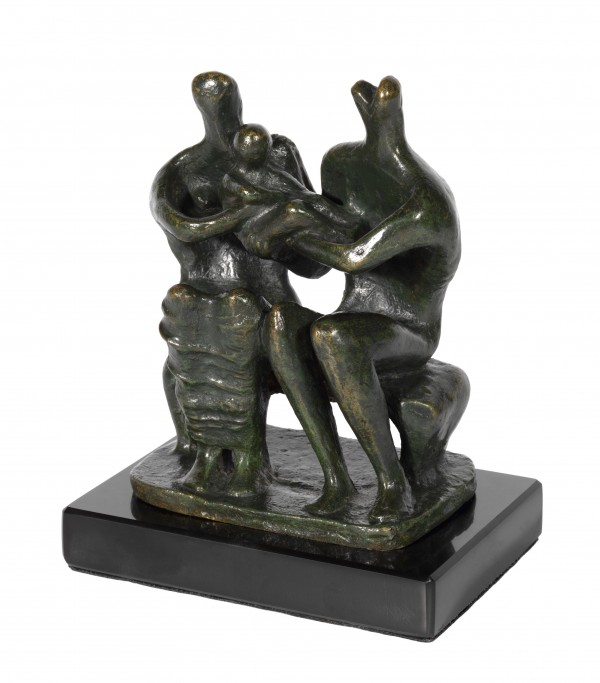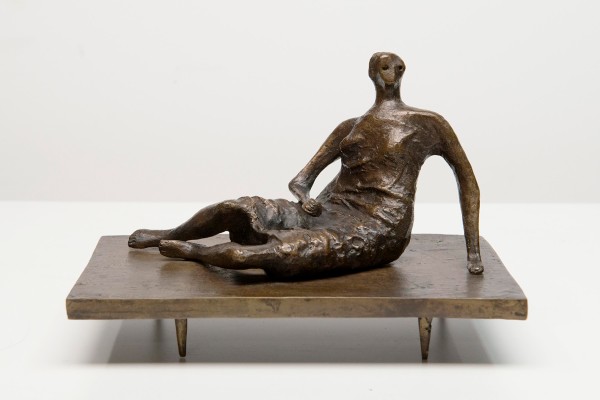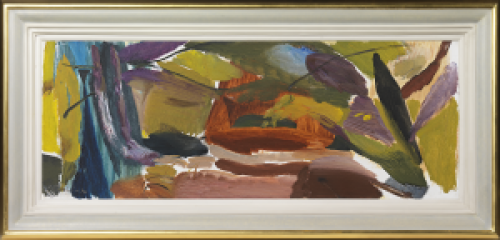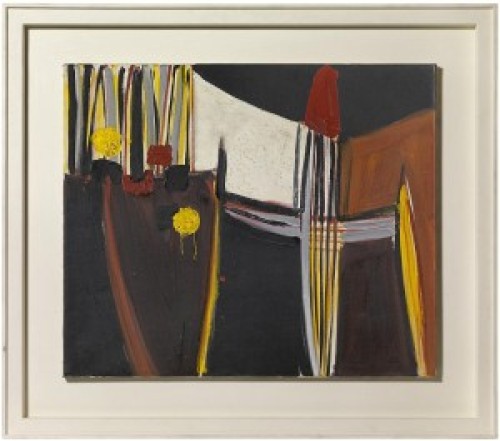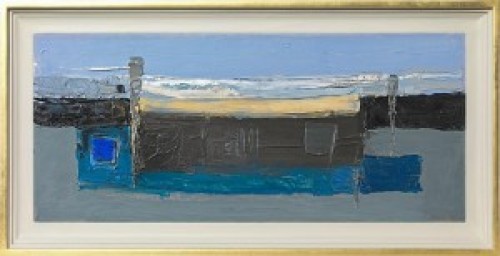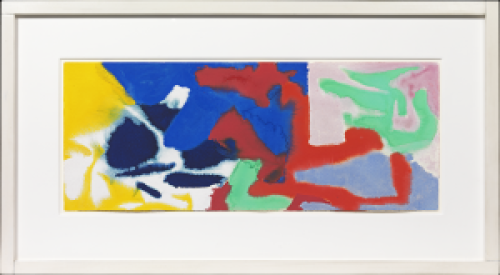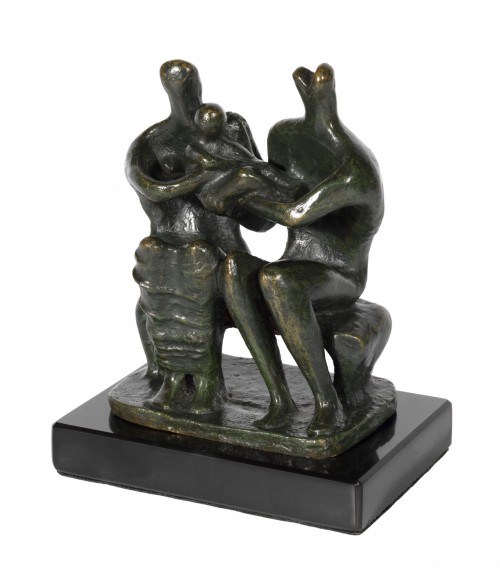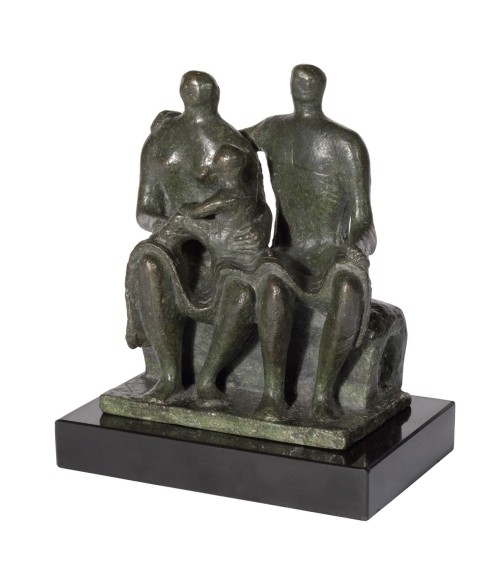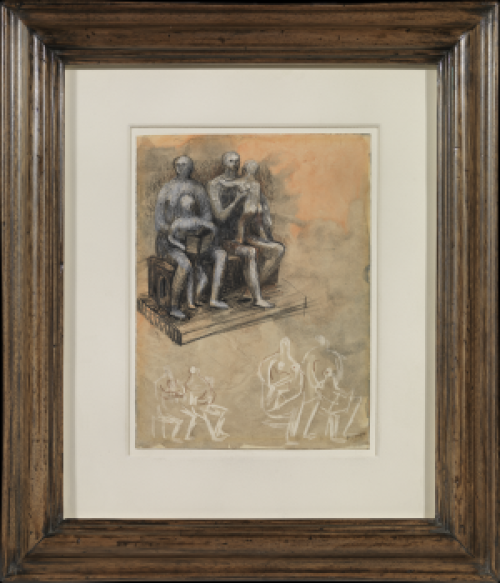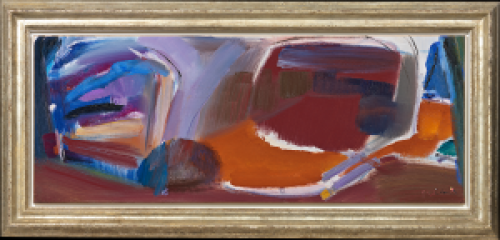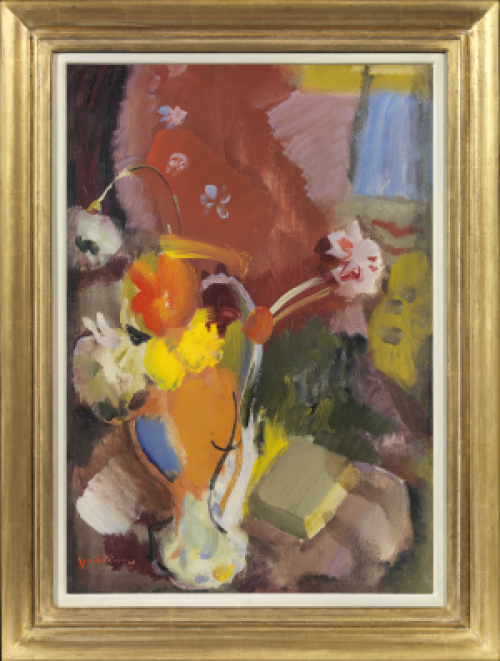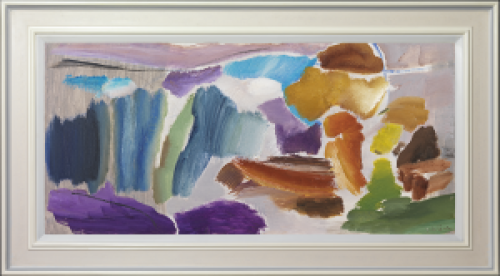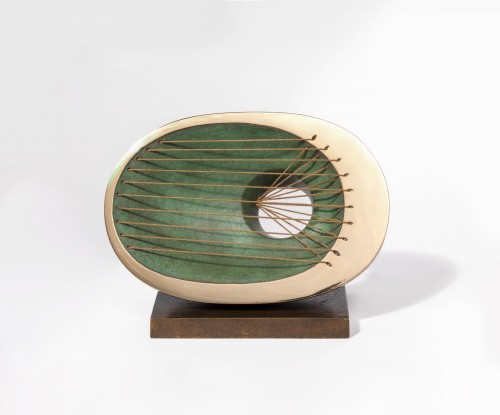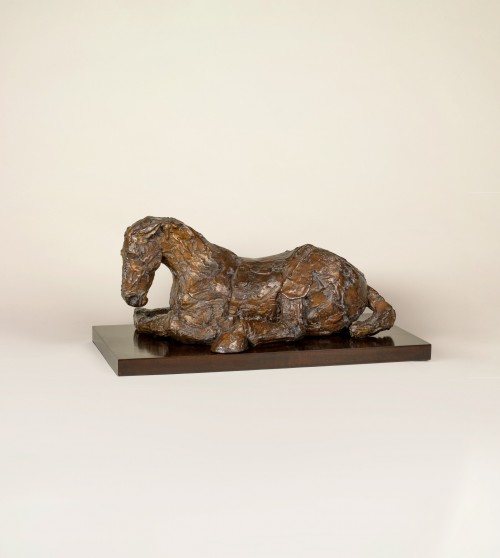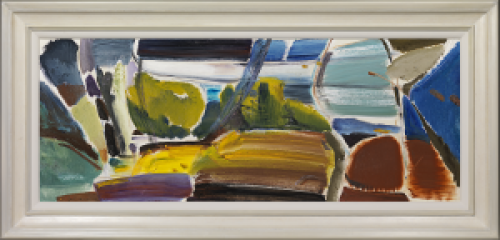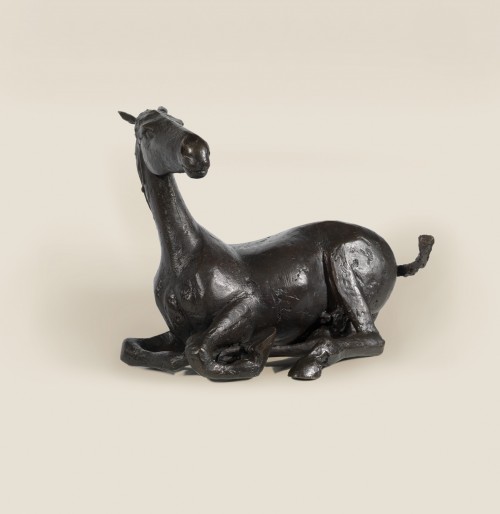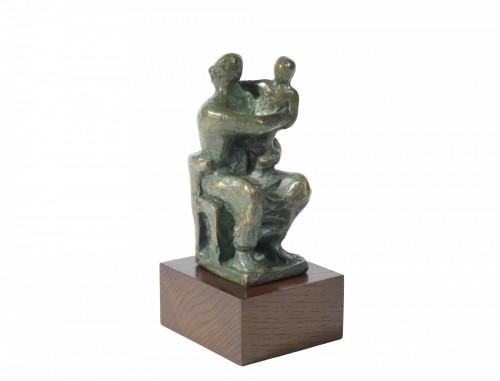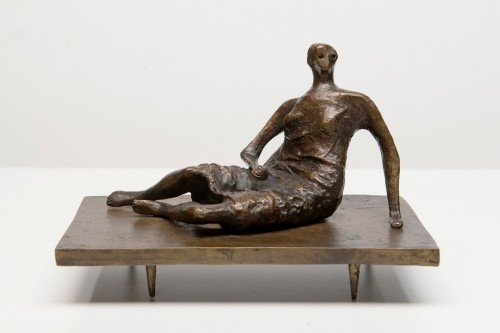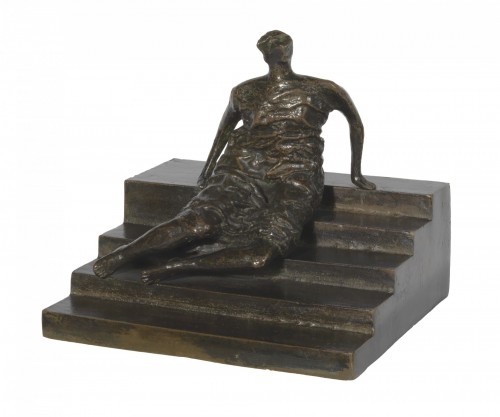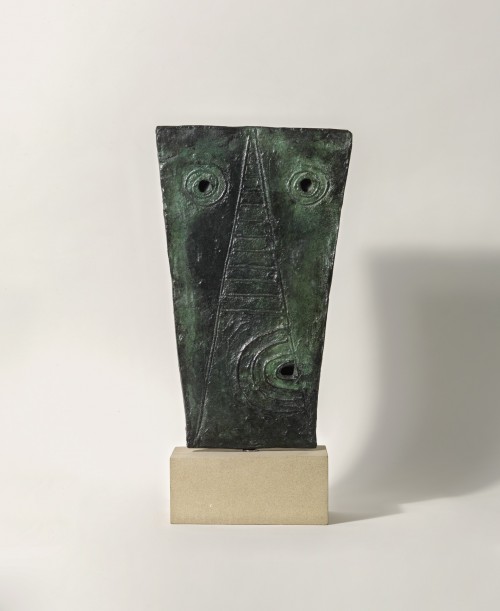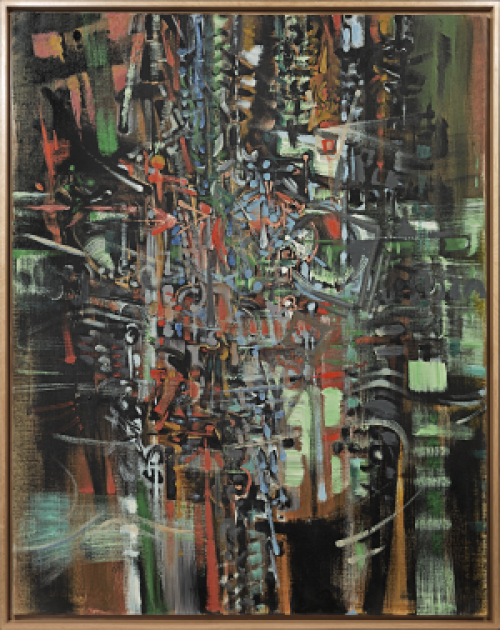HENRY MOORE OM CH
Castleford 1898 - 1986 Much Hadham
Ref: BR 47
Maquette for Mother and child with apple
Bronze with a reddish brown patina: 6 ¾ x 3 ½ x 4 in /
17.1 x 8.9 x 10.2 cm
On a slate base: 1 x 6 ⅛ x 5 ⅛ in / 2.5 x 15.6 x 13 cm
Conceived and cast in 1956 by Fiorini in an unnumbered edition of 9 plus one artist’s copy
LH 406a
Provenance:
Baron Kenneth Clark (1903-1983), London;
Estate sale, Sotheby Parke Bernet & Co., London, 27th June 1984, lot 60;
Private collection
Literature:
Alan Bowness (ed.), Henry Moore, Complete Sculpture 1955-64, Vol. 3, Lund Humphries, London, 1965 (reprinted 2005), no.406a, another cast illus.
Alan Bowness (ed.), Henry Moore, Complete Sculpture 1964-73, Vol. 4, Lund Humphries, London, 1977 (reprinted 1991), p.31, no.406a
William S Liberman, Henry Moore 60 Years of His Art, Thames & Hudson, London, 1983, another cast illus. p.80
John Hedgecoe, Henry Moore, A Monumental Vision, Collins & Brown, 1998, cat. No.373, another cast illus. p.220
‘Very young babies have always fascinated me; the big head, the frog-like quality of the body, and their kicking vitality.’[1] Henry Moore
An exquisite sculpture with exceptional provenance, Maquette for Mother and child with apple 1956, explores the playful yet protective relationship between a graceful mother and her vivacious child. A sympathetic balance between the serene stability of the seated parent and the lurching animation of the clambering infant, the semi-abstract figures are nonetheless united by the repetition of their curved, open arms, their hands reaching towards and replicating the fascinating fruit. The broad, bowed shoulders of the mother and her elongated arms steady and encircle the dynamic figure of the child, recalling both its birth and rapid development. This elegant and intimate work demonstrates the simultaneous qualities of immediacy and timelessness, the personal and universal, which characterise Moore’s small-scale figures of the mother and child.
Developing from the public commission of a Madonna and Child for the Church of St Matthew’s, Northampton in 1943-44, Moore later wrote of the subject, ‘The ‘Mother and Child’ is one of my two or three obsessions, one of my inexhaustible subjects. This may have something to do with the fact that the ‘Madonna and Child’ was so important in the art of the past and that one loves the old masters and had learned so much from them. But the subject itself it eternal and unending, with so many sculptural possibilities in it – a small form in relation to a big form, the big form protecting the small one, and so on. It is such a rich subject, both humanly and compositionally, that I will always go on using it.’[2]
A cast of the large-scale version of this exceptional bronze, Mother and child with apple (29 ¼ in / 74.5 cm height, in an edition of 10), is at The Study Gallery, Poole, part of Bournemouth & Poole College of Further Education. Moore returned to the subject in 1981 on paper and then selected a work to be woven into one of the largest tapestries produced from his drawings in 1982-83, both in the collection of the Henry Moore Foundation.
The art patron and historian, Baron Kenneth Clark (1903-1983), was the original owner of this exceptional work and one of the most influential figures in British art of the twentieth century. A close friend of the artist, Clark purchased drawings from Moore’s first solo exhibition at the Warren Gallery in 1928 and continued to collect his work throughout his lifetime. He also played a pivotal role in museum purchases of his work, including the Museum of Modern Art, New York and the Tate Gallery, London, prior to the Second World War. During the War, Clark proposed and became Chairman of the government’s War Artists’ Advisory Committee, in which role he recommended Moore be made an Official War Artist and commissioned his shelter drawings, which radically transformed the artist’s reputation. Famous for promoting and popularising the arts, especially as presenter and writer of the Television series and book, Civilisation, 1969, Clark was also Director of the National Gallery, London from 1935 to 1945, Surveyor of the Kings Pictures, 1934-44, Slade Professor of Fine Art at Oxford, 1946-50, and Chairman of the Arts Council, 1953-60, as well as Chairman of the Independent Television Authority, 1954-57.
The seventh child of Raymond Spencer and Mary Moore, Henry was born in Castleford, Yorkshire in 1898. His paternal great-grandfather was of Irish origin, but his father and grandfather were born in Yorkshire where, for two or three generations, they worked the land or went down the mines. At the age of twelve Moore obtained a grant to study at the Grammar School in Castleford where he was inspired by his art teacher to pursue a career in the arts. In 1916 he began to teach, but by February 1917 he had joined the army and left to fight in France. After being wounded in action in November 1917 at the battle of Cambrai, Moore was excused from active service. He returned to England, where he became a physical education instructor in the army. At the end of the war, Moore received a veteran’s grant to study at Leeds School of Art and in 1921 he joined a course at the Royal College of Art in London. A further grant enabled him to travel extensively from 1925, visiting Rome, Florence, Venice, Ravenna and Paris, where he met Picasso, Giacometti, Ernst, Eluard and Breton among others. On returning from his travels Moore was appointed Professor of Sculpture at the Royal College of Art where he worked two days a week until 1931, as well as teaching at the Chelsea School of Art until 1939. He was appointed an Official War Artist during the Second World War from 1940–1942 for which he made a series of drawings of people sheltering in the London Underground, as well as studies of miners at the coal face. In these pictures he frequently used watercolour over wax crayon. After the war Moore enjoyed a great deal of success, with his works receiving critical acclaim all around the world. He executed many major commissions for museums, public institutions, private collectors and municipal buildings and as a result he became one of the most famous British artists of the twentieth century. At the beginning of the 1970s Moore created a foundation, the aim of which was to promote public awareness of sculpture and to protect his own work for the future. Located in his home village of Much Hadham, Hertfordshire, the foundation houses a library, archives and a collection of drawings, prints, maquettes and sculptures by the artist. Heavily influenced by the work of Michelangelo, Moore created monumental works in marble, stone and bronze and was enthralled by the theme of the family, and in particular the mother and child. His unique oeuvre draws inspiration from prehistoric, archaic, Egyptian, African, Mexican and Roman sculpture. Throughout his career he was noted for his output of graphic art – drawings, watercolours, etchings and lithographs which were not necessarily related to individual sculptures.
[1]The artist cited in John Hedgecoe, Henry Moore, Simon & Schuster, New York, 1968, p.175.
[2] The artist cited in Alan Wilkinson (ed.), Henry Moore, Writings and Conversations, Berkeley, 2002, p.213.

